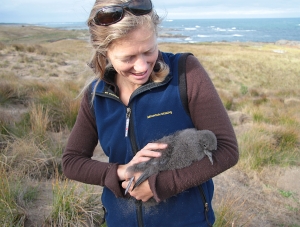Nature on the move
Research news
Whether it be butterflies that weigh less than a gram, 40-ton whales - or the billions of animals in between - about one fifth of all species fly, walk or swim their way across the planet each year in their pursuit of food, safety and reproduction.
Deakin ecologist Dr Bethany Hoye says that the experts have neglected a vital piece of the biodiversity puzzle. This is the fact that billions of animals spend their lives on the move.
In a paper just published in the world’s leading scientific journal “Science,” Dr Hoye, from Deakin’s Centre for Integrative Ecology, and her colleague Dr Silke Bauer demonstrate the massive impact that migration has on ecosystems. They also illustrate the devastating consequences that can occur when migration is altered as a result of barriers (such as dammed streams), over-exploitation, habitat loss or climate change.
“Migrating animals effect the total ecosystem they are inhabiting at a specific time, including plants, animals, agriculture, parasites and the microscopic environment,” Dr Hoye said.
“They are a unique, but highly influential part of biodiversity. They transport nutrients and other organisms, such as seeds or parasites, they feed, and they are preyed upon, effecting resident communities in a myriad of different ways.”
Dr Hoye believes that the sheer scale of migration and the complexity of the interactions involved has meant that most scientists have failed to factor migration into their study of ecology.
“The scale is phenomenal. 1855 bird species migrate each year, which is about 20 per cent of all bird life. In the insect world, the figures are even more staggering. Three billion insects migrate annually over any one-kilometre stretch in southern England.”
While the scale suggests that detailed research is impossible, Dr Hoye and Dr Bauer, an expert from the Swiss Ornithological Institute, who is currently on sabbatical at Deakin, suggest that “network theory” provides the way forward for scientists.
Originating in the field of mathematics, network theory has been used increasingly over the past decade in finance, IT, economics and sociology as a way of understanding extremely complex systems.
“Network theory basically involves using matrices to outline the interactions between different entities – such as species or locations. These are then overlaid to build up a complete picture of how the animal is connected with other members of an ecological community at a particular time of year,” Dr Hoye explained.
She added that scientists are starting to develop large scale movement databases to show where specific species are at different times of the year.
High tech tracking systems are transforming scientists’ understanding of migration. While, once, researchers would use rings and volunteers in other parts of the world to track individual animals, tracking devices that weigh as little as half a gram now allow scientists to trace migratory routes with incredible accuracy. Satellite transmitters or miniscule light meters connected to digital clocks can pinpoint exactly where in the world an animal has been.
Dr Hoye believes that the complex study of migration is imperative for ecologists, given the environmental challenges of the future. She and Dr Bauer suggest that the most logical place to start is in areas where the most data is already available, or where significant changes are being observed.
“Ecosystems have evolved over thousands of years to depend on migration, so that if animals do not appear when they should, or they appear in significantly different numbers, there can be fundamental disruption,” she said.
Dr Hoye and Dr Bauer, who met while Dr Hoye was doing doctoral research in the Netherlands, have several new projects planned, including looking at the effects of anthropogenic (human) activities on migrants and their ecosystem services, and the potential for infection to alter migration behaviour.
“It has been great being at Deakin, in my first visit to Australia,” Dr Bauer said. “I am enjoying collaborating with my colleagues, especially Bethany, because of our strong shared research interests.”
She added that she is looking forward to ongoing collaboration with Deakin - and like many of the animals she is studying - expects to pay more visits to Australia.
Share this story
 Destined for travel... Dr Bethany Hoye cradles a short-tailed shearwater chick on King Island.
Destined for travel... Dr Bethany Hoye cradles a short-tailed shearwater chick on King Island.
